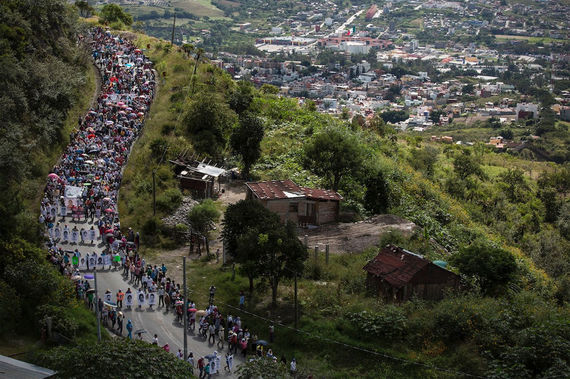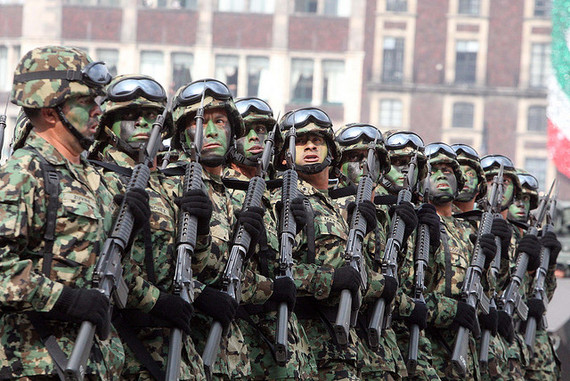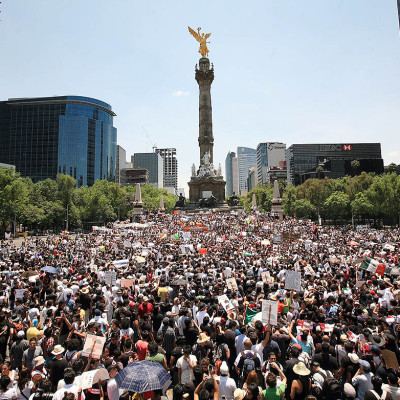Troubling Questions on Role of Military in Ayotzinapa Case as National Crisis Builds:
When Iguala, Guerrero municipal police and masked men in unmarked black uniforms opened fire on unarmed students from the Ayotzinapa teachers college last September, killing six people and kidnapping 43 students, they lit the fuse of a national crisis.
The atrocity triggered outrage because it illuminated the shadowy collaboration between local police, political bosses, militarized criminal gangs, and other state actors. It also raised deeply troubling questions about the role of Mexico's armed forces that remain unanswered.
Mexico's political class and governing institutions are suddenly under attack and discredited on a scale not seen for generations. The poor, angry, politically savvy and mostly rural families of the murdered and disappeared students are at the lead of a fast growing dissident movement that has the attention and sympathy of tens of millions of Mexicans. It should have the attention of the U.S. public and foreign policy decision makers as well.
A confrontation looms. Last week the families of the 43 disappeared students rejected the findings of the Mexican Attorney General who declared the students dead. His findings were based on the confessions of alleged participants, who described mass slaughter and the burning of corpses at a garbage dump.
Instead, the families announced that three caravans would simultaneously crisscross the country to gather allies in the continued fight for their children. Their organized fury represents a genuine threat to the image-dependent, investor-friendly regime of President Enrique Peña Nieto, who brought the notorious PRI back to power just two years ago.
But President Peña Nieto's administration represents just the surface layer of regime power. The true bedrock of Mexico's "stability" is the Armed Forces. Historically, the high command of the armed forces prefers to stay out of public view, but during every moment of national crisis over the last 85 years their role has been decisive.
The Armed Forces crushed the railroad workers strike of 1959 and massacred hundreds of students to defeat the democratic movement of 1968. During the "dirty war" of the 1970s, the army massively deployed to Guerrero where they massacred whole rural villages in a bid to annihilate the base of a guerrilla "party of the poor", led by teachers who had graduated from the Ayotzinapa college in the 1950s.
The Armed Forces backed former President Carlos Salinas after his fraudulent election in 1988; and then again in 1994, when the army attacked and corralled indigenous base communities of the Zapatista movement in Chiapas, suppressing their NAFTA inspired uprising.
In 2006, the military stepped in again after another fraud-tainted election. In the wake of his contested inauguration, President Felipe Calderon was unable speak in public without being confronted by angry citizens. Instead, he called the press to an army base; where, with the active support of the Bush administration, he declared war on a vague set of "enemies", whose only common denominator was that they all somehow profited from the illegal drug trade.
Calderon got his ratings spike, but the war he promoted didn't make sense then, and it doesn't make sense now.
During a seven-year period that produced 100,000 murders, 20,000 disappearances, and dotted the Mexican countryside with mass gravesites, the U.S. contributed almost 3 billion dollars in military and police assistance. That needs to change.
A 2011 Human Rights Watch report, subtitled Killings, Torture, and Disappearances in Mexico's "War on Drugs" documents armed forces involvement in, and their evasion of responsibility for, human rights crimes across Mexico. It includes a chilling case study of the alleged army abduction and disappearance of six civilians in Iguala, Guerrero in March, 2010.
In the Ayotzinapa case, suspicion of the army is based on its failure to respond on September 26, as uniformed men firing automatic weapons deployed and forcibly abducted dozens of students during a three-hour period just 1.2 miles on federal highways from a major army base. Why didn't the Army launch a search for the students in the critical early hours after being informed of the mass abductions?
As the families of the missing students take their fight against President Peña Nieto's government to the national level, the Armed Forces will be under great scrutiny. Any excessive use of force or, worse yet, killing of protestors will rain repudiation down on them.
In the United States, where more than 35 million people of Mexican origin live, solidarity marches are being planned in more than 50 cities on December 3rd, to demand the U.S. suspend military aid, and for the Mexican Armed Forces to hold their fire and let change happen.



